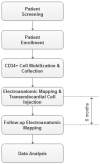Transendocardial CD34+ Cell Therapy Improves Local Mechanical Dyssynchrony in Patients With Nonischemic Dilated Cardiomyopathy
- PMID: 35320035
- PMCID: PMC8949703
- DOI: 10.1177/09636897221080384
Transendocardial CD34+ Cell Therapy Improves Local Mechanical Dyssynchrony in Patients With Nonischemic Dilated Cardiomyopathy
Abstract
We investigated the effects of cell therapy on local mechanical dyssynchrony (LMD) in patients with nonischemic dilated cardiomyopathy (NICM). We analyzed electromechanical data of 30 NICM patients undergoing CD34+ cell transplantation. All patients underwent bone marrow stimulation; CD34+ cells were collected by apheresis and injected transendocardially. At baseline and at 6 months after therapy, we performed electromechanical mapping and measured unipolar voltage (UV) and LMD at cell injection sites. LMD was defined as a temporal difference between global and segmental peak systolic displacement normalized to the average duration of the RR interval. Favorable clinical response was defined as increase in the left ventricular ejection fraction (LVEF) ≥5% between baseline and 6 months. Using paired electromechanical point-by-point analysis, we were able to identify 233 sites of CD34+ cell injections in 30 patients. We found no overall differences in local UV between baseline and 6 months (10.7 ± 4.1 mV vs 10.0 ± 3.6 mV, P = 0.42). In contrast, LMD decreased significantly (17 ± 17% at baseline vs 13 ± 12% at 6 months, P = 0.00007). Favorable clinical response at 6 months was found in 19 (63%) patients (group A), and 11 (37%) patients did not respond to cell therapy (group B). At baseline, the two groups did not differ in age, gender, LVEF, or N terminal-pro brain natriuretic peptide (NT-proBNP) levels. Similarly, we found no differences in baseline UV (9.5 ± 2.9 mV in group A vs 8.6 ± 2.4 mV in group B, P = 0.41) or LMD at cell injection sites (17 ± 19% vs 16 ± 14%, P = 0.64). In contrast, at 6 months, we found higher UV in group A (10.0 ± 3.1 mV vs 7.4 ± 1.9 mV in group B, P = 0.04). Furthermore, when compared with group B, patients in group A displayed a significantly lower LMD (11 ± 12% vs 16 ± 10%, P = 0.002). Thus, it appears that favorable clinical effects of cell therapy in NICM patients may be associated with a decrease of LMD at cell injection sites.
Keywords: dilated cardiomyopathy; mechanical dyssynchrony; stem cells.
Conflict of interest statement
Figures




Similar articles
-
Effects of Repetitive Transendocardial CD34+ Cell Transplantation in Patients With Nonischemic Dilated Cardiomyopathy.Circ Res. 2018 Jul 20;123(3):389-396. doi: 10.1161/CIRCRESAHA.117.312170. Epub 2018 Jun 7. Circ Res. 2018. PMID: 29880546 Clinical Trial.
-
Comparison of transendocardial and intracoronary CD34+ cell transplantation in patients with nonischemic dilated cardiomyopathy.Circulation. 2013 Sep 10;128(11 Suppl 1):S42-9. doi: 10.1161/CIRCULATIONAHA.112.000230. Circulation. 2013. PMID: 24030420 Clinical Trial.
-
Efficacy of CD34+ Stem Cell Therapy in Nonischemic Dilated Cardiomyopathy Is Absent in Patients With Diabetes but Preserved in Patients With Insulin Resistance.Stem Cells Transl Med. 2016 May;5(5):632-8. doi: 10.5966/sctm.2015-0172. Epub 2016 Mar 29. Stem Cells Transl Med. 2016. PMID: 27025690 Free PMC article. Clinical Trial.
-
Cell therapy for nonischemic dilated cardiomyopathy: A systematic review and meta-analysis of randomized controlled trials.Stem Cells Transl Med. 2021 Oct;10(10):1394-1405. doi: 10.1002/sctm.21-0094. Epub 2021 Aug 4. Stem Cells Transl Med. 2021. PMID: 34346555 Free PMC article.
-
CD34+ stem cell therapy in nonischemic dilated cardiomyopathy patients.Clin Pharmacol Ther. 2013 Oct;94(4):452-8. doi: 10.1038/clpt.2013.134. Epub 2013 Jul 31. Clin Pharmacol Ther. 2013. PMID: 23903668 Review.
References
-
- Bozkurt B, Colvin M, Cook J, Cooper LT, Deswal A, Fonarow GC, Francis GS, Lenihan D, Lewis EF, McNamara DM, Pahl E, et al.. Current diagnostic and treatment strategies for specific dilated cardiomyopathies: a scientific statement from the American Heart Association. Circulation. 2016;134(23):e579–646. - PubMed
-
- Kass DA. An epidemic of dyssynchrony: but what does it mean? J Am Coll Cardiol. 2008;51(1):12–7. - PubMed
-
- Ghio S, Constantin C, Klersy C, Serio A, Fontana A, Campana C, Tavazzi L. Interventricular and intraventricular dyssynchrony are common in heart failure patients, regardless of QRS duration. Eur Heart J. 2004;25(7):571–8. - PubMed
-
- Fauchier L, Marie O, Casset-Senon D, Babuty D, Cosnay P, Fauchier JP. Interventricular and intraventricular dyssynchrony in idiopathic dilated cardiomyopathy: a prognostic study with fourier phase analysis of radionuclide angioscintigraphy. J Am Coll Cardiol. 2002;40(11):2022–30. - PubMed
Publication types
MeSH terms
Substances
LinkOut - more resources
Full Text Sources
Research Materials

